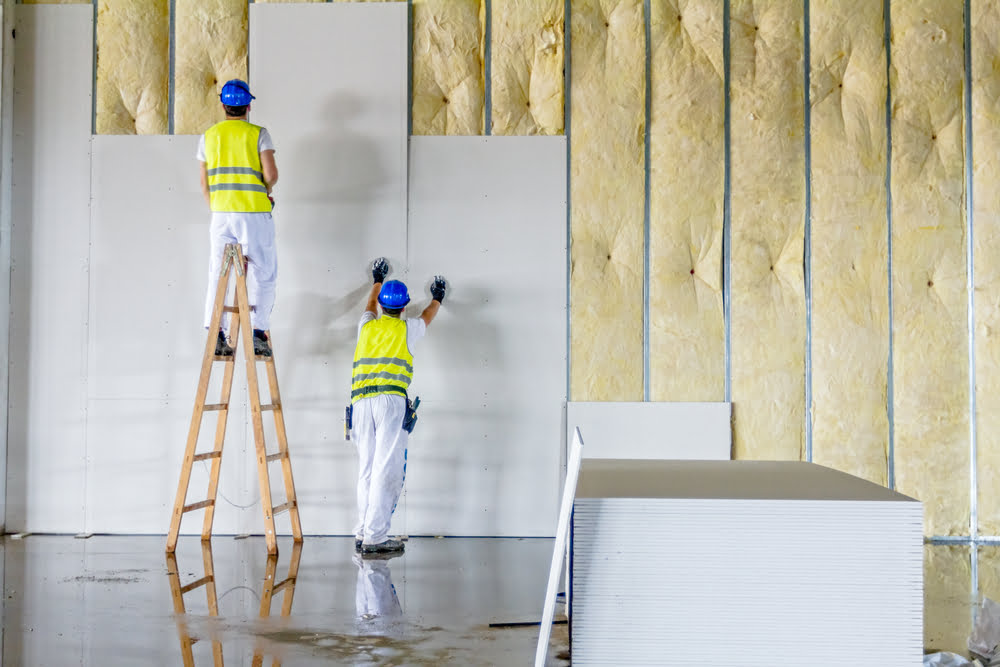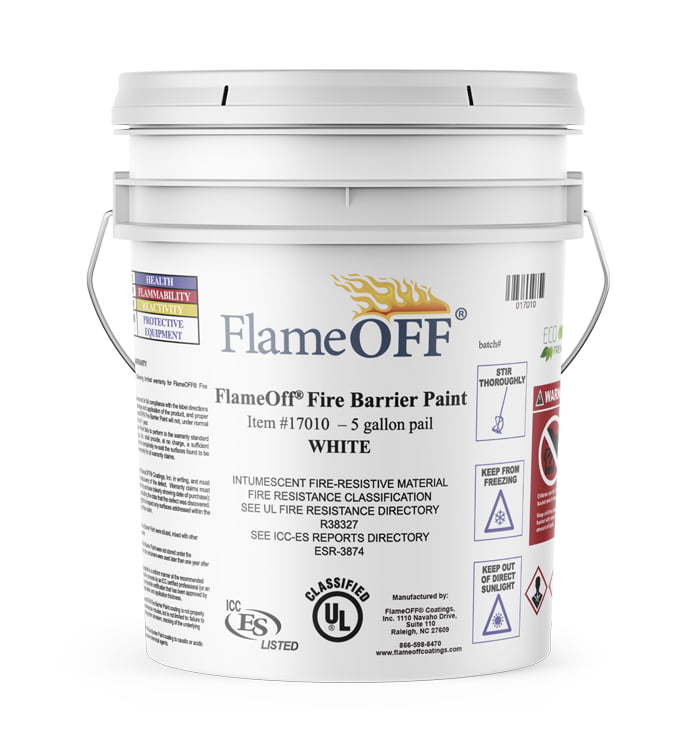
Preventing the spread of fire starts with choosing building materials with the right fire-rating and price point for your project. Fire-rated drywall is one of the many fireproofing options that can protect your next construction project. In this rundown, we’ll take a look at the types of fire-rated drywall, how they work, and how much each type will cost you.
Table of Contents
Introduction to Fire-Rated Drywall
While all drywall has a degree of fire resistance, fire-rated drywall offers greater structural stability and resistance to fire over a longer period. These properties make fire-rated drywall vital in large-scale construction.
The difference lies in fire-rate drywall’s composition. A standard drywall panel consists of sheets of gypsum beneath an outer layer of paper. Gypsum has a high water content, which allows it to resist burning for about an hour.
However, the intense heat of a fire will eventually cause this water to evaporate, weakening the structure of the drywall as the gypsum shrinks. This can cause the drywall to break apart or collapse, letting the flames spread to other spaces.
Fire-rated drywall, on the other hand, is fortified with thin glass fibers that help maintain its structural integrity after the water evaporates. Fire-rated drywall may also use vermiculite, a mineral that expands when exposed to heat, to prevent collapse by filling the space left by the water.
Just how much fire-resistance does fire-rated drywall provide? A regular drywall panel typically offers up to 1 hour of fire resistance, but fire-rated drywall can provide up to 4 hours, depending on the type of drywall and its fire rating classification.
Types of Fire-Rated Drywall
Fire-rated drywall comes in two types: Type X and Type C. Both are fortified with fiberglass, but each has different applications and fire-resistance ratings.
Type X drywall is the more common variety, and is used in commercial as well as residential buildings. It’s typically installed in spaces that are the most likely to catch fire, such as kitchens and boiler rooms. At ⅝ of an inch thick, it’s also thicker than standard drywall.
Type C drywall contains both glass fibers and vermiculite, and is frequently used in larger constructions, like multi-family housing units and industrial facilities. Notably, Type C drywall is used in stairwells and elevator shafts, where fire can easily climb to the upper floors.
Like Type X, Type C drywall is thicker than standard drywall. You can find it in either ⅝-inch or ½-inch panels.
Type C drywall is typically needed in parts of a building that require specific fire resistance times according to UL 263, ASTM E119, or other local standards.
When it comes to fire resistance, Type X drywall offers 1 to 2 hours of resistance and Type C can exceed the 2-hour fire rating. However, it’s important to note that the fire ratings of drywall are based on their performance in a full fireproofing system. In other words, it won’t matter what kind of drywall you use if a room has unsealed gaps where hot gasses can escape.
Meeting E-119 Fire Rating Standards
While gypsum offers passive fire suppression by naturally resisting catching fire, this resistance must still be tested to meet certain standards.
The ASTM E-119 standards require products to undergo testing to qualify as fire-resistant. A product’s E-119 fire rating determines how long it can resist the high heat of a fire as well as the sudden cooling and impact of fire hoses.
For example, a product with a 1-hour fire rating means that its material will resist burning or collapsing for one hour. Similarly, 2-hour fire-rated drywall will resist damage for two hours.
If you need to meet E-119 ASTM standards, you might need a fire resistant coating. A fire resistant paint, like FlameOFF Fire Barrier Paint, can improve your fire rating to ensure E-119 ASTM standards.
Best Intumescent Paint
Learn more about FlameOFF Fire Barrier Paint here.
How to Improve the Fire Rating of Drywall
Let’s say you want to install Type X drywall in your facility to meet building code requirements, but you want to increase its fire rating beyond just an hour. Applying an intumescent paint to your fire-rated drywall can add one to two hours of extra protection.
Intumescent paint creates a barrier against fire by expanding under high heat, buying more time before the drywall is affected. In our example, applying intumescent paint could double or triple the fire rating of your Type X drywall.
To ensure that your fire resistant coating provides meaningful protection, it’s important to prepare drywall by sanding it and clearing away the dust so that the paint will be applied evenly.
The Cost of Fire-Rated Drywall
Due to its thickness and additional fire-resistant materials, fire-rated drywall is more expensive than regular drywall. Type X drywall panels generally cost around 30% more, and Type C drywall tends to be twice as expensive as standard drywall.
Here’s an example of how significant that price difference can be. Let’s say you need to install drywall in a 100 x 50 x 12 foot mechanical room. With a total wall area of 3,600 square feet, you would need 112.5 4×8 drywall panels to finish it—we’ll round that up to 113.
If you choose Type X panels, at $18 per panel you’d pay $2,034. With Type C panels, at $28 per panel, you’d pay $3,653. That’s a difference of $1,619 for a single room in your facility.
Those prices are approximate, but should give you an idea of how the price differential can add up when installing drywall on a large scale. Additionally, you’ll need to consider the cost of dry wall installers, which will typically run you anywhere from $50 – $100 per hour.
